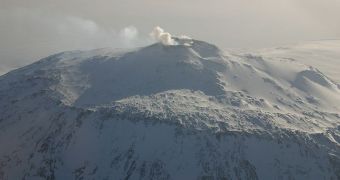A recent analysis of the western Antarctic ice sheet (WAIS) has revealed a swarm of tremors, one of the clearest signs indicating an upcoming volcanic eruption. For a long time, researchers believed that the volcanoes under the Southern Continent were dead, but this appears not to be the case.
The tremor swarms could be indicative of the fact that volcanoes underneath the WAIS are still pretty much active, and that they could potentially erupt soon. According to geologists, these small tremors are produced by magma flowing inside its chamber under the volcanoes.
When pressure in this chamber climbs to high, eruptions are very likely to occur. However, this is not set in stone, because each volcano has its particular type of plumbing. This means that the conduits used by magma to fill the magma chamber differ in diameter, length, convolution and so on.
Scientists have been keeping an eye on active Antarctic surface volcanoes, such as Mound Erebus, for a long time, but they did not consider than an eruption may come from beneath the miles of ice covering Antarctica's surface, RT reports.
The recent study that discovered the underground tremor and volcanic threat under the WAIS was published in the November 17 issue of the top scientific journal Nature Geoscience. The research team says this discovery may turn out to have some effect on global climate change patterns.
Scientists led by Amanda Lough from the Washington University in Saint Louis say that the buried volcanoes are part of the Executive Committee Range, and are located in Marie Byrd Land. These volcanoes are very young – the oldest are just 13.2 million years old, while the youngest is less than 1 million years old.
Lough and her team identified the tremor swarms by analyzing data from seismic stations installed in the region. The group covered information gathered between 2007 and 2010, and revealed an intensification in magma activity under the Executive Committee Range.
The accumulation of excess magma under the crust was also confirmed by satellites responsible for measuring variations in Earth's gravitational pull. Such a deviation was found over the mountain range, suggesting that more matter (in this case, magma) lies in the same space than before.
Volcanic eruptions in the WAIS could be a problem because this area is already the fastest-melting in Antarctica. An under-ice event would melt only the bottom layer of the ice, turning it into a slushy that would enable ices above to flow even faster towards the ocean. This could in turn contribute to a faster global sea level rise.

 14 DAY TRIAL //
14 DAY TRIAL //